Unsubscribe
Gmail says your unsubscribe "Needs work"
- steve
- Jul 11, 2025
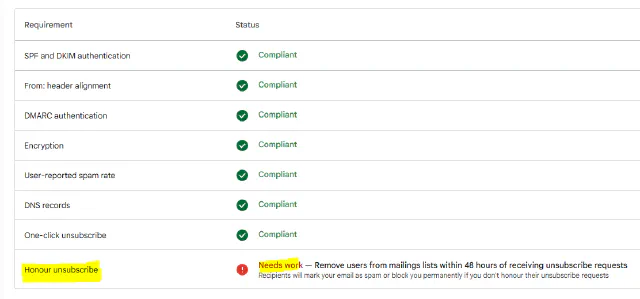
Needs work?
We’ve written about RFC 8058 “one-click” unsubscribe and how it’s part of the requirements for bulk senders wanting to deliver mail to the major consumer mailbox providers.
Read MoreOne-click unsubscribe
- steve
- Jan 31, 2024
The worst thing about the yahoogle requirements has been their use of the term “one-click unsubscribe”. It’s an overloaded term that’s being used here to mean RFC 8058 in-app unsubscription. That’s a completely different thing to what one-click unsubscription has been used to mean for decades, often in the context of complying with legal requirements around unsubscription.
Read MoreUnsubscribe vs Suppress
- steve
- Aug 4, 2023
When someone sends a complaint to your compliance desk there are a range of things you want to do, but one thing you always want to do is ensure that the recipient doesn’t receive any more unwanted email from your customer. Or, at least, not from your network.
Read MoreHow to Unsubscribe
- steve
- Jul 26, 2023
Eventually our subscribers won’t want our email in their inbox any more.
Read MoreApple one time email addresses
- laura
- Jun 5, 2019
At WWDC 2019 Apple announced “Sign in with Apple.” This is a service that allows iOS users to log into different applications with private, dedicated email address. When developers send mail to that address, Apple will forward it to the email address associated with the users AppleID. App developers that offer any third party log in will be required to also offer AppleID log in.
Read MoreOne subscription should equal one unsubscription
- laura
- Feb 1, 2019
One of the side effects of using tagged addresses to sign up for things is seeing exactly what companies do with your data once they get it.
Read MoreJane! Stop this crazy thing!
- laura
- Oct 18, 2018
One of the consequences of moving to Ireland is I’m unsubscribing from most commercial mail, including some lists I’ve been on for a decade or more. Sadly, many of the companies don’t ship to Ireland, or their shipping costs are prohibitively expensive. Even if I wanted to purchase from them, I couldn’t.
Read MoreI subscribed to what?
- laura
- May 24, 2018
Tomorrow is GDPR day. That’s the day when the new Global Data Protection Regulations take effect in the EU. I’m sure everyone reading this blog has seen dozens, if not hundreds, of blog posts, articles, webinars, and guidance docs about how to comply. I’m not going to rehash it because, other folks know this better than me.
There are a some things I’m finding fascinating watching this whole GDPR thing.
First, the number of companies who have my addresses and I don’t know why. Take Newsweek (yes, the magazine people). They’re sending GDPR notifications to my LinkedIn address. I can’t figure out why they’re harvesting / buying addresses from LinkedIn. Then there’s SALESmango who are some company that started spamming me a few years ago and refuses to accept unsubscribe request. They’re sending me opt-in requests. Yeah, no, go away. I told you to stop, but wow, you won’t.
Another interesting piece is just how much I’ve signed up for over the last 18 – 20 years I’ve been using this set of addresses. Wow. So much mail. And, generally, I thought of myself as relatively careful in who I gave email addresses to. I don’t normally go around dropping addresses into forms but even a couple a month adds up over 20 years.
Then there are the companies violating CAN SPAM in one way or another. Sending mail to unsubscribed addresses and refusing to include an opt-out link are the two things I’ve seen regularly. Yeah, no. I think it’s safe to say that if I’ve opted out from receiving your mail, you should probably put my data away in a dark closet and not touch it again. But.. but.. but… But nothing. Go away. As for the lack of an unsubscribe link, get over yourself. You’re not that special. I don’t think that this really is something that counts for exemption.
Also, is there an official template? So many of these emails look identical. I have to give credit to whomever did it first. Because if plagiarism is the sincerest form of praise, you have an entire industry praising you.
Finally, it’s been amusing to watch the general frustration with all the GDPR mail. It seems many people are getting tired of the deluge. That’s OK, though, it should end by Saturday. Or so we can only hope.
Don't bother unsubscribing
- laura
- Apr 17, 2018
In the early years of the spam problem, a common piece of advice was to never unsubscribe. At the time, this made a lot of sense. Multiple anti-spammers documented spammers harvesting addresses from unsubscribe forms. This activity tapered off around 2000 or so, although the myth persisted for much longer.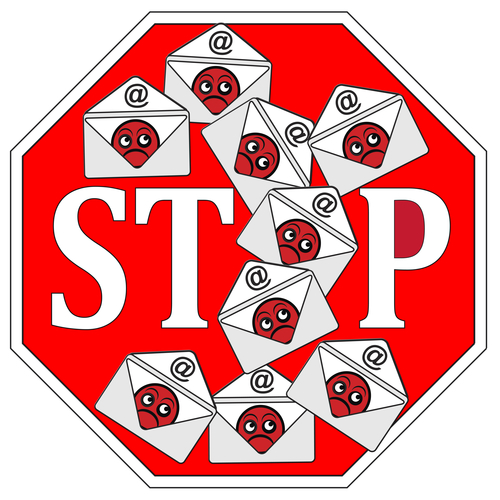
These days, there isn’t much harm in unsubscribing. I even spent a full month unsubscribing from spam at one of my dormant accounts (Yes, spam is still a problem). While the graph shows an initial increase in spam, levels dropped for the next few months. By the time I cancelled the account in 2017, spam levels were at very low. I don’t know if the decrease was due to the unsubscribing or if there were improvements in the filtering appliance the ISP used.
More recently the biggest problem is senders that don’t honor unsubscribes. There are a lot of reasons this can happen and they’re not all malicious. Still, too many companies don’t care enough to actually make sure their unsubscribe process is working. I’ve had way too many companies “lose” unsubscribe requests, sometimes years after I asked them to stop. I expect many of these cases are accidents. They switch ESPs and decide or forget or otherwise fail to transfer unsubscribes to the new ESP. But, in other cases, there doesn’t seem to be any ESP change. It appears the companies think that they can reactivate unsubscribes at some point (pro tip: there is no expiration on legally required unsubscribe requests).
All of this leads to my current recommendation: yeah, unsub if you feel like it, it’s unlikely to hurt, and it’s possible it will help. But, don’t expect them to actually work permanently. Companies just don’t care enough to make them permanent.
December 2016: The Month in Email
- laura
- Jan 4, 2017
Happy New Year! We’re looking forward to some interesting new projects this year, both for our clients and for Word to the Wise. Stay tuned!
December was a slow month for blogging, with everything going on. But we’re back on the horse now and ready to blog for 2017.
List and subscription management continue to be hot topics, especially in the wake of the listbombing attacks earlier this year. Earlier this month, I presented a webinar on listbombing for the EEC and DMA to review the attacks and discuss best practices for companies to manage subscriptions. For Ask Laura, I wrote about the unsubscribe process and how senders can best manage those requests to keep their lists current and compliant.
With all the holiday mail flying around, Steve wrote up a good post about the challenges of DNS hosting and issues customers may have reaching your site. He also wrote about canonicalization, a process for comparing things to see if they are the same, which is useful for understanding how messages change during the delivery process. It’s important to understand how this works with DKIM, as that process specifically looks at changes to messages in delivery to validate them.
I wrote a post about how delivery at Gmail is a bit different from other mail providers, which can lead to intermittent delivery problems, and got some useful information in the comments about some upcoming process changes. And as always, unwanted email is SPAM. It doesn’t matter if you call it outreach or prospecting, or “here’s something you might find interesting!” Still SPAM.
Ask Laura: Should we confirm unsubscribes?
- laura
- Dec 9, 2016
Dear Laura,
We have some questions about best practices for unsubscribes. Our ESP uses the List-Unsubscribe header by default on every email. I’m not familiar with this, and I have some questions for you.
First, do you think this is a good idea? Should we always use it, or just for certain emails? Should we use the mailto:link or link to a web site to unsubscribe?
We were also asked about double opt-out and if we should do it. We’re thinking that if someone clicks on the unsubscribe link they would be directed to a site displaying a message such as “Sorry to see you go. We have sent an email out for you to fully unsubscribe from the mailing list”. They then have to open the email and click on the link. Do you recommend doing this? Are there anti-spam regulations that this might violate?
And then, once someone unsubscribes (either with double opt-out or not), should we send out some sort of email confirmation? We currently do not, but we’re thinking of sending something like “Sorry to see you go. If you unsubscribed accidentally please click here to re-subscribe.” What do you think?
Thanks,
Breaking Up Is Hard to Do
Recipients and the Spam Button
- laura
- Nov 18, 2016
Earlier this week Litmus and Fluent hosted a webinar title “Adapting to Consumers’ New Definition of Spam.” This had a number of fascinating facts about email marketing, many of which should reassure folks. Litmus has a blog post up highlighting some of the findings specific to millennials and email. Good news is millennials like getting mail from brands and interact with them regularly. Even better, they will rescue mail out of the spam folder.
Litmus has a blog post up highlighting some of the findings specific to millennials and email. Good news is millennials like getting mail from brands and interact with them regularly. Even better, they will rescue mail out of the spam folder.
The full whitepaper is available from Fluent: 2016 Consumer Perceptions of Email. I’ll be writing more about this over the interesting tidbits here over the next few weeks. But I really suggest people go download it and read it.
iOS List Unsubscribe Functionality
- laura
- Sep 26, 2016
Al did a great post over on Spamresource about the how the new list unsubscribe function in the default mail client from iOS10. What’s been interesting to me is how much I’m hearing from ESP folks about how their customers want it gone.
If you don’t know what we’re talking about, in the default mail client on iOS10, Apple is now offering a way to unsubscribe from list mail by placing an unsubscribe link at the top of the message.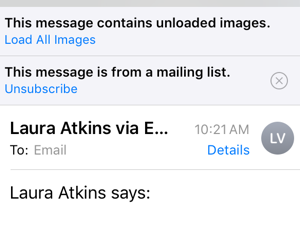
As you can see, this isn’t just for commercial mail, it’s in place for every mailing list that has a List-Unsubscribe header. (This is a screenshot from something I posted to OI this morning). For me, it’s somewhat intrusive. I’m on a lot of discussion lists – technical, marketing, business and even a couple social ones. Reading them on my phone has become a challenge, as every email in a thread contains the “unsubscribe” button now.
Luckily, you can dismiss the message for all posts to that mailing list by hitting the ⮾⮾⮾⮾x. Interestingly, once you’ve turned it off there seems to be no way to turn it back on for that list.
Senders have different complaints, however, they do not have to do with intrusiveness or usability issues.
I’ve heard complaints about placement and about how easy it makes it to unsubscribe. One person even stated that everyone knows the place for an unsubscribe is at the bottom of a message and it should never be at the top of a message. I find these arguments unpersuasive. Unsubscribing should be easy. Unsubscribing should be trivial. People should be able to stop getting mail on a whim. Particularly here in the US, where unsolicited mail is legal, being able to quickly opt-out is the only thing keeping some of our mailboxes useful.
I’ve also heard some concerns that are a little more understandable. One company was concerned that unsubscribes go directly to their ESP rather than directly to them. This is a somewhat more understandable concern. Good senders use unsubscribes as part of their KPIs and as part of their campaign metrics. They know how much an unsubscribe costs them and will use that as part of their metrics for defining a successful campaign. Still, though, it’s not that big a concern. ESPs are already handling these kinds of unsubscribes from providers like gmail and hotmail.
Almost 7 years ago I blogged about a sender who wanted an unsubscribe link in the email client. It was a bit of snark on my part. The interesting part, though, is that some senders want unsubscribe mediated in the client and others things it’s horrible. I think this tells me that there’s no universal right answer. It Depends might be the most hated statement in deliverability, but it is the absolutely the reality of the situation.
Mail Client Improvements
- laura
- Sep 16, 2016
There’s been extensive and ongoing development of email through the years, but much of it has been behind the scenes. We were focused on the technology and safety and robustness of the channel. We’re not done yet, but things are much better than they were.
The good part of that is there is some space to make improvements to the inbox as well. Over the last few months there have been a number of announcements from different mail client providers about how they’re updating their mail client.
NY Times on unsubscribing by email
- laura
- Sep 1, 2016
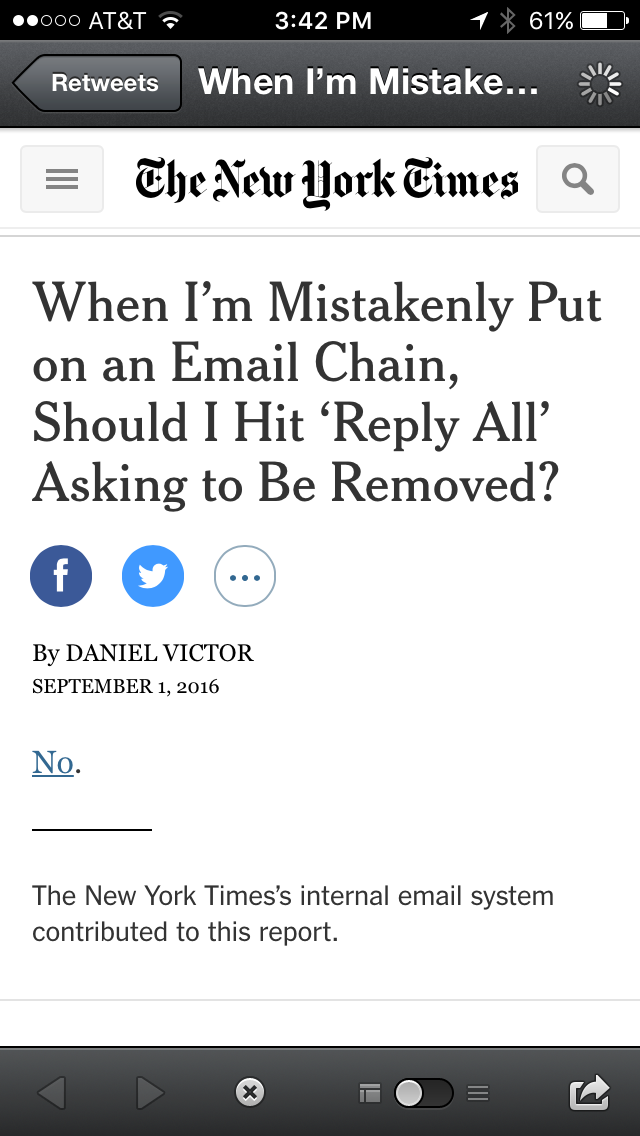
More than a decade ago I was included in one of these. It wasn’t work related per se, but the address list included a lot of experienced, BTDT, names-on-RFCs technology folks.
Yeah, even they got stuck in the mess of replying all, unsubscribing, lecturing people about not replying to all. It was a mess, but funny given the names involved. #neverdothis #noreplytoall
iOS mail supporting list-unsub header
- laura
- Jun 21, 2016
Al over at SpamResource reports that the next generation of Apple’s iOS has support for the list unsubscribe header.
To the best of my knowledge, this is the first time an independent email client has built in support for the List-Unsubscribe header. Microsoft and Google support it, but only in their webmail system. Hopefully other mail clients will follow suit.
Ask Laura: What about Transactional Opt-Outs?
- laura
- May 20, 2016
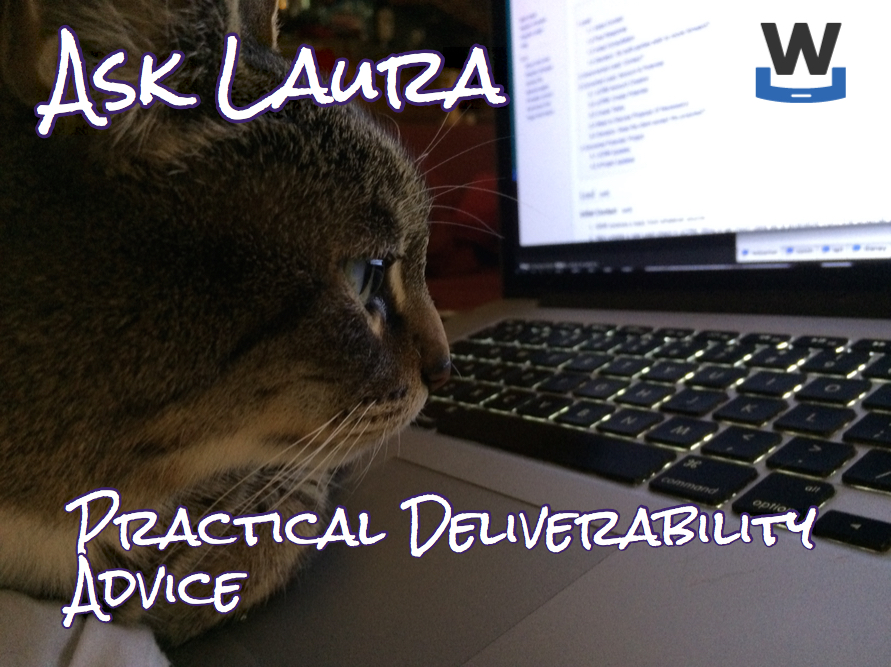
Dear Laura,
We are having a bit of an internal struggle on our end as we launch our new quarterly account summaries. What are your views on including an unsubscribe link in these emails?
My personal opinion is that we should. Although the summaries can be classified as “transactional”, they are not tied to a specific recent transaction a customer made and can be viewed as a general reminder to shop again. As I gathered data to present my case, I reviewed several different account summaries and I found it split close to 50/50. Do you have any data or thoughts to support one way or another?
Thanks,
Summary Judgement
Doing it right
- steve
- Dec 29, 2015
It’s that time of the year – marketers send more email than usual, recipients unsubscribe from their lists.
Clicking on the unsubscription link in the email I just received took me to an unsubscription landing page. The box for my email address was prepopulated based on the cookie in the unsubscription link, the default setting is to unsubscribe me from all mail from the sender and just clicking the sole button on the page will unsubscribe me.
It offers me an alternative to unsubscribing from everything – letting me receive just the content I want. It does that immediately on the unsubscription landing page (rather than suggesting I go to a subscription center or, worse, requiring I click on a different link in the mail originally). And it tells me the important things about the newsletters I might want to subscribe to – what they’re about and how often they’re sent.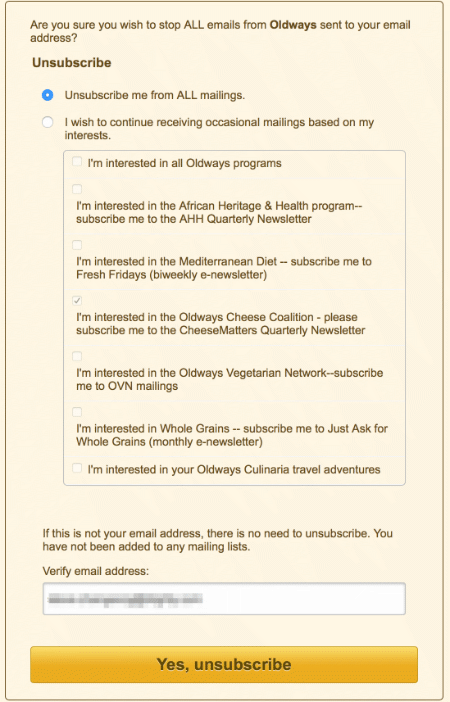
This isn’t anything particularly special, but sometimes it’s nice to highlight someone who is doing it right.
Monitoring Your Mail Stream
- laura
- Aug 7, 2015
One of the most important things for any mail sender to do is monitor their mail stream. There are a number of things that every mailer should pay attention to. Some are things to monitor during delivery, some are things to monitor after delivery. All of these things tell senders important information about how their mail is being received by their recipients and the ISPs.
Read MoreTesting your opt-out process
- josh
- Jun 19, 2015
When was the last time you tested your opt-out process? Did you just click the unsubscribe link to see if the page loaded? How did you confirm the email address was unsubscribed?
If you have a Gmail account, Gmail allows you to use unlimited aliases. For example, if your Gmail email address is josh@gmail.com, you can add the + symbol to your email address to create an alias. An example of an alias would be josh+test1@gmail.com. Sending an email to josh+test1@gmail.com gets delivered to the mailbox for josh@gmail.com.
On your next mailing add a Gmail alias email address like josh+unsubtest06192015@gmail.com to be included with the mailing. After sending the mailing, find the email sent to the alias address and go through the unsubscribe process. After unsubscribing, log into your ESP or mailing software to confirm that the alias email address was successfully unsubscribed. Testing the unsubscribe process ensures that the landing page for the unsubscribe is working and that your ESP is registering the unsubscribe request.
A few reminders about your unsubscribe page:
On Father's Day
- steve
- Jun 18, 2015

I’m on quite a few mailing lists for companies whose main product is sending gifts: food hampers, jewelry, flowers, overpriced desk toys and so on. They tend to ramp up their volume before appropriate holidays such as Christmas, Mother’s Day, Thanksgiving, Valentine’s Day or Father’s Day and target their promotions to those particular holidays.
One recipient may have a toxic relationship with their Mother and not want to be reminded of Mother’s Day, another may have recently lost their Father and not want to revisit that distress every time they open their mail client in June, yet another may be recently divorced and really not want to see diamonds and roses in their inbox right now.
You should try and avoid sending mail that will distress your recipients. You should do that because you’re a compassionate human and you want to treat your recipients as humans. But if you need an ROI argument to justify the effort needed to do so… those recipients will associate your brand with that distress and then they’ll buy less or they’ll unsubscribe and you’ll lose their business entirely – even if they are interested in and responsive to your offers for the rest of the year.
How do you identify those recipients? Maybe just ask them. Or add an “Unsubscribe from Father’s Day promotions” link next to the “Unsubscribe” link – it’s not hard to do. Help your customers segment your list for you.
Recipients need to be able to unsubscribe
- laura
- Mar 26, 2015
The The Canadian Radio-television and Telecommunications Commission (CRTC) announced today that Plentyoffish Media paid a $48,000 fine for CASL violations. According to the CRTC news release, Plentyoffish Media was failing to allow consumers to unsubscribe from mail in compliance with CASL.
CASL requires that any commercial electronic email message contain an easy and free unsubscribe mechanism. Plentyoffish sent mail to its members without an unsubscribe mechanism. According to their webpage (HT: Sanket) there were some messages that users were unable to opt-out of without closing their account.
My holiday email prediction
- laura
- Nov 26, 2014
I was on IRC with a group of ESP delivery specialists last week and one of them was looking for something to blog about. I suggested a list of holiday predictions. Not that I have a huge number of holiday predictions, but I did come up with one.
During the holiday season at least one retailer will decide that they have information so important that they will ignore my opt-0ut request and add me to their holiday blast list.
So what’s your holiday email prediction?
August 2014: The Month in Email
- laura
- Sep 3, 2014
Isn’t August the month where things are supposed to slow down? We’re still waiting for that to happen around here… it’s been great to be busy, but we’re hoping to continue to carve out more time for blogging as we move into the fall.
As usual, we reported on a mix of industry trends and news, the persistence of spam, and did a deep dive into an interesting technical topic. Let’s start there: Steve wrote a post explaining Asynchronous Bounces (yes, it’s a GNFAB), with some examples of how they’re used and how they can cause operational problems.
In industry news, we did a roundup post of some Gmail changes and a followup post on security issues with non-Latin characters in addresses. We also celebrated the long-awaited release of a wonderful resource from MAAWG that I am very proud to have helped author, the white paper Help! I’m on a Blocklist! (PDF link). We receive dozens of these calls every week, and though we are always happy to help people solve urgent delivery crises, we spend most of our consulting time and attention working with people to build sustainable email programs, so this document is a great “self-service” resource for people looking to troubleshoot blocklist issues on their own.
In other industry and MAAWG-related news, we noted that the nomination period for the J.D. Falk award has opened (you have just a few more days, procrastinators) and took a moment to reminisce about our friend J.D. and his incredible contributions to the field.
On the topic of creating, sending, and reading more attractive email, we posted some resources from Mailchimp and crowdsourcing templates from Send With Us. We also incorrectly reported on a not-actually-new interface from AOL, Alto. Interesting to note that there’s been so little followup from AOL (and almost no post-launch coverage) in the two years since launch.
We also touched on a few myths: email saves trees and low complaint volume is good.
And finally, in November of 2013, I unsubscribed from every possible email I received on a specific account. I followed up on that briefly in a Part 2 post, and this month went back and wrote a Part 3 followup. Spoiler alert: spam is still a problem. Of course, we got some comments that we were probably doing it wrong, so Unsubscribe Barbie showed up to add her thoughts. We try not to be snarky around here, but sometimes we just don’t try very hard.
Unsubscribing is hard
- laura
- Aug 20, 2014
A comment came through on my post about unsubscribing that helpfully told me that the problem was I didn’t unsubscribe correctly.
As you know, there are usually two unsubscribe options in many of the bulk senders emails. Are you unsubscribing from the global or the offer unsub? Unless you are unsubscribing from both, you will still be on the lists.
To address the underlying question, I did unsubscribe from both links for those very few mails in my mailbox that had double unsubscribe links. I know that some spammers use multiple unsubscribe links in their emails. We routinely recommend clients not use 3rd party mailers with double unsubscribes because it’s a clear sign the 3rd party mailer is a spammer.
Given the presence of double unsubscribes I generally assume the point is to confuse recipients. By having multiple unsubscribe links the spammers can ignore unsubscribe requests with the excuse that “you unsubscribed from the wrong link.” Plausible deniability at its finest. The best part for the spammer is that it doesn’t matter which unsubscribe link the recipient picks, it will always be the Wrong One.
I’ve been dealing with spam since the late 90s, and have been professionally consulting on delivery for over 14 years. If I can’t figure out what link to use to unsubscribe, how is anyone supposed to figure out how to make mail stop?
In some cases, the unsubscribe links admitted that the address I was trying to unsubscribe was already removed from the list. They helpfully refused to let me unsubscribe again through their form. But they offered a second way to unsubscribe.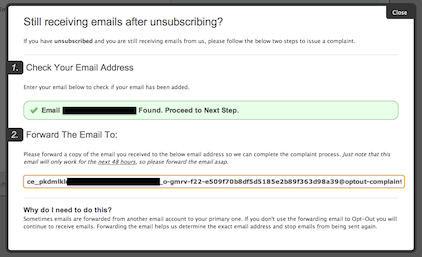
The address I was unsubscribing was the same one I was unsubscribing. Some of the emails even helpfully told me “this email was sent to trapaddress@” which is the address in the above screenshot.
I’m sure my friend will come back and comment with “why didn’t you unsubscribe by forwarding the email?” Because I was spending enough time unsubscribing as it was, and I didn’t want to have to try and navigate yet another unsubscribe process. I knew they weren’t going to stop mailing me, no matter what hoops I jumped through.
I’m not saying that all unsubscribe processes are broken, there are millions and millions of emails sent every day with simple and effective unsubscribe links. What I am saying is that there is a lot of mail getting to inboxes that users never requested nor wanted. “Just unsubscribing” from this mail Does Not Work. It just keeps coming and coming and coming.
But of course, the mail still coming is my fault, as I was unable to correctly unsubscribe. 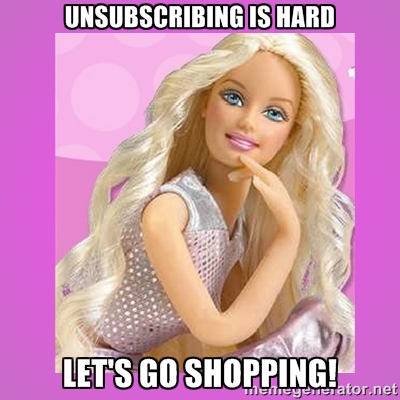
Yes, spam is actually still a problem
- laura
- Aug 19, 2014
I hear a lot of people claim that spam isn’t really a problem any more. That filters are so good that the average user doesn’t see a lot of spam and if they do get “legitimate” mail that they can just opt out.
These are great sounding arguments, the problem is that those arguments aren’t always true.
There is an address I stopped using for commercial mail around 1997 and all mail around 2002. It still gets hundreds of emails a month.
Those hundreds of emails a month are despite the fact that the address is behind commercial spam filters. It’s been on “flamers lists.” It’s on the “do not mail” list that came with the “Millions CD.”
In addition, I am very open with clients (and their affiliates) that this is a “spam trap” address. I’ve handed it out to dozens and dozens of companies over the years describing it as my spam trap address.
In November 2013, I unsubscribed from every single email received at that account – at least those that had unsubscribe links.
What does the mail volume look like now?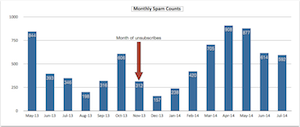
If anything unsubscribing made the volume problems worse. In the best case it lowered the volume briefly to something approaching 10 emails a day.
There are currently over 500 messages I’ve received so far in August. These are messages advertising companies like Laura Ashley, MetLife, Military.com, Quibids, Walk In Tubs, Sainsbury’s, Bloomburg, Fidelity, Oral B, Lasix Vision Institute, Virgin Broadband, ClickNLoan, Timeshares, iMotors, Walmart, oil changes, Experian, Credit monitoring, Life insurance, ADT, CHW Home Warranty, Health Plans of America, Bosley Hair Solutions, Jillian Michaels Online, restaurant coupons, credit cards, SBA loans, and that’s before we get to the Garcinia cambogia, herbal viagra and clearly fraudulent stuff.
This account, that hasn’t been subscribed to anything in more than 10 years is getting hundreds of unasked for emails a month, even with the benefit of commercial filters. It appears to be being sold or traded in multiple countries (Laura Ashley, Virgin Broadband and Sainsbury’s are all in the UK). I don’t want this mail. I have tried to stop getting this mail.
Yes, spam is still a problem.
Some email related news
- laura
- Aug 6, 2014
A couple links to relevant things that are happening in email.
M3AAWG released the Help! I’m on a Blocklist! (PDF link) doc this week. This is the result of 4 years worth of work by a whole lot of people at M3AAWG. I was a part of the working group (“doc champion” in M3AAWG parlance) and want to thank everyone who was involved and contributed to the process. I am very excited this was approved and published so people can take advantage of the collective wisdom of M3AAWG participants.
In other announcements, Gmail announced today on their Google+ page that that they were putting a new “unsubscribe” link next to the sender name when mail is delivered to the Promotions, Social or Forums tab. This appears to be the official announcement of the functionality they announced at the SF M3AAWG last February. It likely means that all users are currently getting the “unsubscribe” link. What Gmail doesn’t mention in that blog post is that this functionality uses the “List-Unsubscribe” header, not the link in the email, but I don’t think anyone except bulk mailers really care about how it’s being done, just that it is.
Also today Gmail announced they were going to recognize usernames with non-Latin or accented characters in the name. Eventually, they claim, they’ll also allow people to get Gmail addresses with accented characters.
Spot the unsub
- laura
- May 27, 2014
A new game! Spot the unsub! Our first challenge is the footer from a major software company. How long does it take for you to to find the unsub link?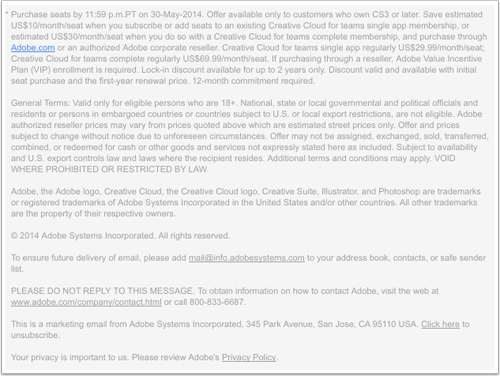
What’s even more annoying is that I never actually subscribed to mail from this company. A few years ago I was doing some work for them and they required I set up an account on their cloud service so they could share docs with me. Last month, they started emailing me as “a customer.” Yeah. No.
Best practices: A Gmail Perspective
- laura
- Mar 7, 2014
At M3AAWG 30 in San Francisco, Gmail representatives presented a session about best practices and what they wanted to see from senders.
I came out of the session with a few takeaways.
Where did you get my address?
- laura
- Jan 25, 2014
Both Steve and I are trying to get answers from Amazon, Target and Epsilon about how Target acquired our Amazon specific email addresses. Target phone reps told us the mail we got was a phish, Epsilon is refusing to acknowledge Target is a customer and Amazon has promised us “they’re looking into it.”
Meanwhile, an address of mine was transferred from one customer of an ESP to another customer of the same ESP. At first I was told I must have signed up for the mail; as proof I was provided with the data I supposedly signed up. When I explained no that wasn’t true, the abuse desk told me they had discovered there was a mistake and that “These two clients use the same 3rd party ESP and they had mixed the files.” I’m not actually sure who “they” refers to, but as long as they’ve untangled the files I am not going to argue. The sad part is that it took an escalation to Return Path (the IP sending the mail is certified) to get anyone to actually respond to my report of an address given to Company A being mailed by Company B.
On the flip side, mail showed up today that actually had a link for “how was I added?”
When you click on the link it shows exactly where the address came from and when it was added to the list.
It would be great if more companies provided this information to their recipients. I think it would probably decrease spam reports and make consumers feel more comfortable about how companies are collecting and using information.
That unsubscribe time of year
- laura
- Dec 18, 2013
Like many people, I make purchases online. This usually means the vendor adds me to their mailing list. I normally don’t care, that mail all filters to my “commercial” folder (my own personal version of tabs) and I can browse it at my leisure.
At this time of year, though, email marketers go into a bit of overdrive and that folder fills with 20 – 30 or more emails a day. The volume is no so much of a problem, but it can get annoying to try and find mail I want in all the crud from random vendors.
In some cases, I don’t even know who the company is or why they have my address. Today’s example was a florist in Maryland. Eventually I figured out I’d purchased from them back in 2007 to send flowers to a colleague when her mother passed away. Apparently, they’re doing so badly they need every dollar they can find.
What it does mean, though, is that I unsubscribe from more mail in December than I do through the rest of the year. I don’t mind the occasional mail, even weekly is no big deal. But when that frequency drastically increases, or someone has not bothered to mail me for 5+ years, I just don’t want that mail anymore.
Dana Perino used the term ‘unsubscribe Tuesday‘
Unsubscribe preference centers
- laura
- Dec 11, 2013
I unsubscribe from a lot of opt-in lists around this time of year. I’m generally unbothered by a couple emails a week from companies I’ve purchased from in the past. But, a lot of these companies drastically increase their volume mid-November. I may not be averse to 3 emails a week, but that absolutely does not mean I want 2 emails a day.
Unsubscribing from spam, part 2
- laura
- Nov 20, 2013
Yesterday I posted about why the reasons a lot of people give for not unsubscribing from spam are mostly wrong. Unsubscribing from spam doesn’t seem to confirm your address and it doesn’t seem to increase your spam load.
But does that mean you should unsubscribe from spam? I’m not sure about that.
I’ve been working on a project where I am unsubscribing from every message coming into one of my email addresses. Weeks into that process I’m not seeing a huge decrease in the amount of mail that address is receiving. In some cases I’m unsubscribing from the same senders multiple times a day and have been for close to 3 weeks.
While unsubscribing doesn’t increase your spam, I’m also not sure it decreases your spam, either. But I’ll have full data and numbers demonstrating that in a few more weeks.
What can have an effect on the amount of spam you get is complaining about spam, at least according to Brian Krebs.
Don't unsubscribe from spam!!
- laura
- Nov 19, 2013
Having been around the email and anti-spam industry for a while, I’ve just about seen and heard it all. In fact, sometimes I’ve been around for the beginning of the myth.
One myth that seems to never actually go away is “unsubscribing just confirms you’re a real address and your address will get sold and your spam load will explode.” This is related but orthogonal to “spammers harvest addresses out of unsubscribe forms.” The reality is that both of these things used to be true. Unsubscribing would confirm your email address and increase your spam load. Spammers would harvest addresses out of unsubscribe forms.
But neither of these things have really been true for the last decade.
I have had clients over the years that are spammers. Some of the are names that you probably would recognize. Some of them are companies we could probably all agree are spammers. Some of them are buying addresses from companies that are spammers. Some of them are companies that have a good mailing program here and then hire snowshoers over there. Sometimes they come to me claiming to be real mailers “with minor delivery problems.” Sometimes they come to me saying that a blocklist has recommended they talk to me about repairing their processes. Sometimes they even actually want to fix things. Sometimes they’re just looking to say that I’ve given them a clean bill of health (which is not something I do).
What that means is that I have lots of addresses on lots of spammer lists. Not just the ones they’ve found, but ones I’ve used to test their systems. I use tagged or disposable addresses for everything. Some of my disposable accounts are only marginally connected to me as I want to see what senders really do for their subscribers rather than what they want me to think they do. The ones I add to their system I use to test their subscription process as well as their unsubscription process.
I have never encountered a situation where unsubscribing one of those addresses caused a “multiplication” (to quote one anti-spammer) of my spam load.
I’ve had cases where my clients have ignored unsubscribes. I’ve had cases where my clients have decided years later to add me to their list again. I’ve had cases where they’ve been bought out and my address has been reactivated by the new owners. I’ve had cases where months or even years of 5xx responses was ignored. I’ve seen just about every bad bit of behavior on behalf of spammers. But I’ve never actually had unsubscribing increase my spam load.
It doesn’t matter how often people demonstrate unsubscribing doesn’t result in more spam in the current email ecosystem. (Ken Magill 2013, NYTimes 2011, dayah.com 2009). It doesn’t matter that many mailers treat “this is spam” button hits the same way they handle unsubscribe requests. The myth still persists.
TWSD: Don't honor opt-outs
- laura
- Aug 13, 2013
One of the big arguments various mailers make is that they make it easy for users to opt-out of mail, so it’s not a big deal. Users who don’t want to receive the mail, can make it stop. This was one of the guiding principles of CAN SPAM. The sender can make the decision to send mail to any recipient but they have to offer an opt-out.
The problem is there are a lot of major companies out there that don’t honor opt-outs. Since earlier this year I’ve been tracking when I opt-out of mail. Why? Because I kept getting the feeling that I’d opted out of mail before, but kept getting it.
The good(?) news is that it wasn’t my imagination, some of these companies aren’t honoring their opt-outs. The bad news is that major companies are not honoring opt-outs.
New unsubscribe methods in the news
- laura
- Jul 30, 2013
The folks at The Daily Show, who brought us the wonderful term “High Volume Email Deployer” so very long ago, are once again leading the way in new unsubscribe technology. Unsubscribe by television.
Meanwhile, the folks at The Daily Mash have a different unsubscribe suggestion.
Barracuda filters clicking all links
- laura
- Jul 13, 2013
Earlier this month I mentioned that a number of people were seeing issues with multiple links in emails being clicked by Barracuda filters. I invited readers to contact me and provide me with any information or evidence they had. Not only did a number of senders contact me, but one of the support reps at Barracuda also contacted me.
At issue is a part of the Barracuda email filter call the intent filter. There are 3 different modules to this filter.
Bad unsubscribe processes
- laura
- Jun 24, 2013
We recently renewed our support contract with VMWare. It’s a weirdly complicated system, in that we can’t buy directly from VMWare, but have to buy through one of their resellers. In this case, we purchased the original hardware from Dell, so we renewed our contract through Dell.
Dell sends my email address over to VMWare as part of the transaction.
My only role in this is as CFO. I approve the purchase and pay the bill. I don’t do anything technical with the license.
The email failures start when VMWare decides that I need to receive mail about some user group meetings they’re holding all over the US. First off, I’m not the right person to be sending this mail to inside our company. I’m the billing contact, not the user contact. Then, they send me mail about meetings all over the US, when they know exactly where I’m located. Would it be so hard to do a semi-personalized version that highlighted the meetings in my local area then pointing out the other locations? Apparently, yes, it is so hard.
The biggest failures, though are in the unsubscribe process.
The unsubscribe page is no big deal. I get to unsub from all VMWare communications, and submit that request without having to figure out what my VMWare password is or anything.
After I hit submit, I’m taken to this page.
Wait? What?
“Thank you for registering?” I didn’t register! I don’t want you to contact me. Plus, this is a HP co-branded page when I’m not a customer of HP. VMWare knows this, they know they got my address from Dell.
The biggest problem is that I’m not sure that my address was actually unsubscribed. I suspect that someone copied a form from elsewhere on the site to use as an unsubscribe form. This person forgot to change the link after the “submit” button was clicked. But what else did they forget to change? Is the unsubscribe actually registered in the database?
I suppose only time will tell if VMWare actually processed my unsubscribe. If they didn’t they’re technically in violation of CAN SPAM.
The lesson, though, is someone should check unsubscribe forms. Someone in marketing should own the unsubscribe process, and that includes confirming that unsubscribe pages work well enough.
Logging in to unsubscribe
- laura
- Mar 11, 2013
I have been talking with a company about their unsubscribe process and their placement of all email preferences behind an account login. In the process, I found a number of extremely useful links about the requirements.
The short version is: under the 2008 FTC rulemaking senders cannot require any information other than an email address and an email preference to opt-out of mail. That means senders can’t charge a fee, they can’t ask for personal information and they can’t require a password or a login to unsubscribe.
I’ve talked about requiring a login to unsubscribe in the past here on the Word to the Wise blog.
Let them go
Questions about CAN SPAM
One click, two click, red click, blue click
How not to handle unsubscribes
I’m not the only person, though, that’s written about this.
The FTC has written about it in the FTC CAN SPAM Compliance Guide for business
Social invading everything
- laura
- Mar 9, 2013
I discovered, inadvertently, that there is a business networking site modeled after dating site. If you’re selling something you go on the site and register as a seller. If you’re buying something you go on the site and register as a buyer. Buyers can post RFIs and sellers can respond.
Decent enough business model, they’ve even fleshed it out so the site itself acts as an invoicing and billing mechanism.
That’s how I discovered it, one of our very large international telco customers decided they wanted to use this site for billing. Many large telcos expect vendors to use their proprietary site, so I wasn’t that surprised when they asked. And, given they’re international being able to bill them electronically just means I don’t have to remember to use the international stamps.
At the behest of our customer, I signed up at the website. It’s like most social networking sites, create a profile, categorize yourself, make everything public. The thing is, I don’t want to use this site to find new customers. I am just using it because one of my current customers is expecting it. Don’t get me wrong, Abacus is a great product and our customers are extremely happy with it, but it’s pretty niche. It’s not something that’s going to be searched for on a generic website.
I thought that when I set my profile to private that would be some sort of signal to keep me out of the main directory of the site. This morning I realized that wasn’t true when I got a bunch of emails telling me about all these companies looking for “business software” (the closest category I could find).
Getting a bunch of irrelevant mail was annoying enough. Even worse, there was no unsub link in the email. Eventually, I discovered an entire page of email options that were not made clear to me up front. I also sent mail to support and suggested that they talk to their lawyers to clarify whether their opt-out option was consistent with CAN SPAM. I’m pretty sure it doesn’t, but I am not a lawyer.
To the company’s credit, they did have good support and my questions through support were answered in a timely fashion. One of their support reps even called me on the phone to clarify what it was that I wanted to happen and walk me through their email options. She was very upfront about yes, they opted everyone in to all the mail at the very beginning of the process. “We’re like match.com for businesses!”
I’m sure there are some businesses that will find this service to be great. But it’s not what I want or need. Despite the fact that their support was so helpful, I don’t have a great feeling about this company. It seems a bit dishonest that I thought I was signing up for a billing portal, but was actually joining “match.com for businesses. Why couldn’t they make that clear in the 7 emails in 2 days “inviting” me to sign up?
I know I’m a little more sensitive to bad mailing processes than most people, but this was quite an unpleasant experience from the multiple identical emails and reminders before I signed up to the irrelevant stuff I got afterwards.
TWSD: Hiding the opt-out
- laura
- Feb 20, 2013
![]()
This is an actual opt-out link that came in a recent email. Sadly, this is a real company, listed on the NYSE sent by a major ESP.
Does CAN SPAM require multiple opt-outs on emails?
- laura
- Jan 17, 2013
Today’s Wednesday question comes from M. B.
My company sometimes sends mail to our list on behalf of 3rd parties. A recent 3rd party told us that CAN SPAM requires the email contain their opt-out link as well as ours. Is this correct?”
Read More
Increasing engagement for delivery?
- laura
- Jan 4, 2013
I’ve talked a lot about engagement here over the years and how increasing engagement can increase inbox delivery.
But does driving engagement always improve delivery?
Take LinkedIn as an example. LinkedIn has started to pop-up a link when users log in. This popup suggests that the user endorse a connection for a particular skill. When the user clicks on the popup, an email is sent to the connection. The endorsement encourages the recipient to visit the LinkedIn website and review endorsements. Once the user is on the site, they receive a popup asking for endorsement of a connection. Drives engagement both on the website and with email. Win for everyone, right?
I get lots of these endorsements, but I’ve had a few that have made me wonder what’s really going on. Are these people really endorsing my skills? If they are then why am I getting endorsements from people I’ve not seen in 15 years and why are some of the endorsed skills things I can’t do?
This morning I asked one of my connections if he really did endorse me for my abilities in Cloud Computing. His response was enlightening.
Yahoo changes
- laura
- Nov 20, 2012
Thanks to tips by a couple blog readers and some clients, I have been looking into Yahoo disabling links in the bulk folder. It does appear Yahoo is no longer allowing users to click on links in emails that Yahoo places in the bulk folder.
In fact, some of the spam in my Yahoo mailbox even has a notice about this.
Let them go!
- laura
- Sep 13, 2012
Unsubscribing should be so simple. Even if someone signed up for mail, senders should let them go when they unsubscribe. Unfortunately, there are a lot of senders that make it difficult to unsubscribe. In fact, many companies are still hiding unsubscribe links behind login pages.
Read MoreQuestions about CAN SPAM.
- laura
- Sep 11, 2012
In the US, the law governing the sending of commercial email is CAN SPAM. I’ve seen a number of questions about CAN SPAM recently.
One came from twitter, where someone was asking if just having an email address meant permission to send to it. Clearly, just being able to dig up an email address doesn’t imply permission to send marketing or commercial email to it. I can promise you April23@contact.wordtothewise.com did not sign up to receive information on increasing Facebook followers.
CAN SPAM doesn’t prohibit unsolicited email. All it says is that if you send unsolicited email you must do a few things.
Check what now?
- laura
- Aug 3, 2012
A client sent me a shot of a page where they were attempting to change their preferences at a website. This is one of my long time clients, and someone who has been in email marketing for years. He tells me that he spent quite a long time staring at the screen trying to figure out what he was supposed to do to opt out.
Leaving money on the table
- laura
- Jul 24, 2012
On August 1 two domains in the Netherlands are going away: wanadoo.nl and orange.nl. Current users of these domains are being transitioned to new addresses at online.nl. Mailchimp has more information and links.
This is a good time for all of us to consider how easy it is for a subscriber to change their address of record. Some senders just have the subscriber unsubscribe from one address and resubscribe for another. This sounds like the simplest way to do things, and it certainly doesn’t take much engineering effort.
But what information do you lose by simply asking subscribers to unsubscribe and resubscribe? It depends on what you’re tracking, but you do lose everything that you track. Preferences, interaction history, purchase history, it’s all gone. Providing a simple way to change an email address of record preserves the information related to that subscriber.
For some senders, keeping subscriber information through different ISPs and email addresses will pay for the development of a preference center. For others, there’s no real value there. How much money are companies leaving on the table by not providing a mechanism for recipients to change their email address?
One Click, Two Click, Red Click, Blue Click
- laura
- Mar 28, 2012
I’ve seen a lot of discussion and arguments over the CAN SPAM rule about whether or not an unsubscribe needs to be a One-Click unsubscribe. It’s gotten so common, I have a stock email I use as a template when wading into such discussions. It’s probably useful for a lot of other people, too, so I thought I’d share.
The regs say:
What not to do
- laura
- Feb 1, 2012
There’s a London concert promoter that’s been spamming our old sales address for 5 or 6 years now. I’ve sent in complaints, I’ve tried to unsubscribe, and the mail still keeps coming. They managed to get through my filters, again, this morning. In a fit of frustration I tweeted about how frustrated I was that they would not stop spamming me.
Well, that got someone’s attention. The person managing their twitter account tweeted at me with an email address and a suggestion to send him my address so he could take care of it. I sent the mail as asked and even got a reply.
Unfortunately, the reply was “I clicked the unsubscribe link at the bottom of the message for you.”
I dunno, maybe his mouse is a magic mouse and, somehow, the click from that magic mouse will be more effective than a click from my not-magic mouse. I’m not holding out much hope, though. I have no doubt that my sales address will keep getting invited to raves in London long after I retire.
Expectations
- laura
- Oct 21, 2011
One of the themes I harp on with clients is setting recipient expectations. Senders that give recipients the information they need to make an informed subscription decision have much higher inbox and response rates than senders that try to mislead their recipients.
Despite the evidence that correctly setting expectations results in better delivery and higher ROI on lists some senders go out of their way to hide terms from recipients. I’ve heard many of those types of comments over the years.
Persistence of unsubscribes
- laura
- Oct 19, 2011
It’s really, really frustrating when an unsubscribe request doesn’t take. And it happens a lot more than many people expect.
Most of the culprits are marketing companies. United Business Media is a huge problem, for instance. I never even signed up for their mail, but they bought an address I’d used to register for a conference. I unsubscribed at least a dozen times, but the mail kept coming. Of course, it wasn’t actually mail I’d unsubscribed from. Every email was part of a different list.
There was no way to find out what lists I was on through their unsubscribe page and preemptively unsubscribe. I tried mailing their privacy department, but it took multiple emails to get any sort of response. Finally, someone responded that they had removed me from all their lists.
Illegal? Probably not. Annoying? Totally.
This is the reason I don’t unsubscribe from mail if I don’t recognize the sender. Too many people who “acquire” my email address without permission don’t actually pay any attention to the law, much less best practices.
The other time I see this problem is with some of the addresses I’ve used for testing customers and their vendors. I unsub from any lists I’ve signed up for when I’ve collected the information I need. It’s not totally unheard of, though, for those addresses to lay dormant for years and then start receiving mail again.
This is a problem. They’re “reactivating” addresses. Again, they’re probably different “lists” so it’s not a CAN SPAM violation, but I don’t really care. I unsubscribed. I don’t want any more of that mail. I really can’t figure out what possesses companies to just decide, after not having interaction with subscribers for years, that the right thing to do is just add those addresses to a new list.
It’s not even like they try and re-engage me. Or ask me to opt-in. All they do is start sending me copies of the Annoying Meme of the Hour newsletter. It’s even more frustrating because I know that the sender has been exposed to best practices. I have spent anywhere from weeks to months helping them create a email marketing program that shouldn’t do this kind of thing.
I’ve tried talking to some clients after this happens. Usually, the issue is the marketers or IT staff that I worked with are gone. A new, shiny marketing group has moved in and decided that they had this huge database and of COURSE they should mail it, all of it, opt-outs notwithstanding.
It happens to me as a consumer and subscriber, too. In those cases I don’t have much recourse beyond reporting it as spam and blocking the mail. I don’t trust that a new unsubscribe will work, since the last one didn’t. I have to take other steps to make the mail stop.
In this case, I am much less persistent than the sender is. I think it would be better if senders actually believed me when I said I didn’t want their mail. But I don’t expect that will ever happen. Too many senders think they know better.
Have you audited your program lately?
- laura
- Jul 28, 2011
A few months ago, I got spammed by a major brand. I know their ESP takes abuse seriously, so I sent a note into their abuse desk. It bounced with a 550 user unknown. I sent another note into a different abuse address, it bounced. I sent mail into their corporate HQ, it disappeared into a black hole. I eventually connected with their delivery person and he’d not seen hide nor hair of any complaint. Their entire abuse handling system had broken down and no one noticed.
In the recent past, I was dealing with a client’s SBL listing. We were talking about how their fairly clean subscription process ended up with multiple Spamhaus spamtraps on the list. They mentioned bounce handling, and that they’d not been correctly managing bounces for some period of time. Their bounce handling system was broken and no one noticed.
Last year, I was working with another client. They were looking at why some subscribers were complaining about unsubscribes not taking. A bit of poking at different forms and they realized that one of their old templates pointed to an old website. Their unsubscription form had broken and no one noticed.
Another client insisted that their engagement handling removed any addresses that didn’t open or click on mail. But after ignoring their mail for 6 months, they still hadn’t stopped mailing me. Their engagement handling was broken and no one noticed.
Periodic monitoring would have caught all of these things before they became a big enough problem to result in a Spamhaus listing, or recipient complaints, or lawsuits for failure to honor CAN SPAM. Unfortunately, many companies don’t check to make sure their internal processes are working very often.
Email marketing is not set and forget. You need to monitor what is happening. You need to make sure that your processes are still in place and things are still working.
End of quarter spam
- laura
- May 27, 2011
There has been a plethora of big brand companies doing stupid stuff with marketing recently. I can only figure it’s end of quarter and everyone is looking to pump up their numbers as fast as possible.
I talked about Millenium hotels sending me with an utterly irrelevant ad earlier this week.
@Yahoomail direct message spammed all their twitter followers with an ad for something related to the new Yahoo mail product.
Anyone watching my twitter feed yesterday probably noticed me complaining about spam from Dell.
All of these things are just examples of sloppy marketing. In Dell’s case it’s even worse because they sent me multiple copies of the spam to different addresses. Two copies of the same “SHOP NOW!” email to different addresses, one of which has never been given to Dell.
Mail to the first address is unquestionably spam and I did send in a complaint to Dell’s ESP. That address is never used to sign up for anything. I did try clicking on the “update your subscription” link in the footer and Dell’s website helpfully told me that address was not on their mailing lists. Looks like Dell bought a list.
The second address is one that was involved with the purchase of software from Dell last July. This is the first non-transactional mail sent to that address. I can’t necessarily call the email spam as I did give it to Dell during the course of a transaction. However, Dell could have done a lot better in managing our “relationship” than they did.
Dell collected my email address as part of a transaction in July 2010. They did not start sending marketing mail to this address until May 2011. While Dell is a major brand and most people would recognize the name and may be a little less inclined to hit “this is spam” waiting 10 months between a purchase and regular mailings is a bad idea. People who don’t use tagged addresses may forget they gave the sender an email address and automatically send in a spam complaint.
Sitting on an address for 10 months means Dell really should have done a welcome series, or even just a single welcome email, to ease the transition from no mail to regular mail. But, no, they just send me an email advertising their sales.
We’ve been Dell customers for quite a while, and all of our purchases have been enterprise grade hardware or software to run on those servers. We’ve never purchased anything remotely like office computers. But the sales flyer was for desktops, printers and monitors. Dell knows what I purchased from there, so why are they sending me ads for things I’ve never bought?
We have our own Dell sales rep, and my only involvement in the transaction is source of payment. Adding me to a product list really feels like spam.
Then there was the email itself. The “update your subscription” link was broken and told me I wasn’t subscribed to their list. I mentioned it to Steve and he pointed out that particular link had been broken “forever.” How long has it been since anyone inside of Dell has checked that their footer links work?
What is Dell up to? Who knows. But they unarguably are sending mail to addresses that never opted in. And even if you consider an email giving during a purchase process their handling of that particular address was appalling and in violation of almost every good practice out there.
Does your unsubscribe process work? Are you sure?
- steve
- Mar 30, 2011
I stumbled across an interesting problem today.
A company I bought something from a while back added me to their newsletter. They seem to be having trouble making sales this quarter, as they’ve gone from an occasional email every few weeks to bombarding me with increasingly desperate offers in the past week or two. So I do what most recipients do in that situation (well, the ones who don’t just mark the mail as spam, anyway). I click the unsubscribe link.
I get a perfectly normal, standard unsubscription page, with a nice, prominent “Unsubscribe from all” button with good text explaining that that will remove me from all of the companies mailing lists. No requirements to log in, set dozens of checkboxes or provide a password I don’t have. So far this is a textbook example of a good unsubscription process.
I click the button. Nothing happens. That’s not good.
So I grab one of the people I know over at that ESP and we start looking at it. He clicks the button, and it loads a new page saying that I’ve been unsubscribed from all of the companies mailing lists.
A bit more testing shows that the unsubscription works if you use Internet Explorer or Firefox, but not if you use Safari. The cause of the bug was threefold:
Fines for not honoring unsubscribes
- laura
- Jan 17, 2011
Virgin Blue has been fined $110,000 by the Australian government for not honoring unsubscribes.
Read MoreClicktracking link abuse
- steve
- Oct 11, 2010
If you use redirection links in the emails you send out, where a click on the link goes to your server – so you can record that someone clicked – before redirecting to the real destination, then you’ve probably already thought about how they can be abused.
Redirection links are simple in concept – you include a link that points to your webserver in email that you send out, then when recipients click on it they end up at your webserver. Instead of displaying a page, though, your webserver sends what’s called a “302 redirect” to send the recipients web browser on to the real destination. How does your webserver know where to redirect to? There are several different ways, with different tradeoffs:
Improving the email interface
- laura
- Mar 4, 2010
Want an improved email interface? Then build it.
There’s been an ongoing discussion about adding thumbs up / thumbs down style buttons to email clients. While I am dubious this is a useful feature or something that recipients will use, if there are others in the industry that think it would be useful then I strongly suggest they go ahead and create it.
In fact, there are a couple things that have been asked for in email interfaces that aren’t currently provided. Last October I blogged about adding an unsubscribe button to email clients.
TWSD: My lunch is not spam
- laura
- Oct 16, 2009
My ISP information page occasionally gets trackback pings from various blog posts. This week one of the trackbacks was from a blog post titled “One man’s Spam is another man’s lunch.” The theme of the blog post was that email marketers are poor, put upon business people that have to contend with all sorts of horrible responses from recipients, spam filtering companies and ISPs.
Since the poster took the time to link to my blog, I thought I’d take the time to look in detail at his post and talk about how likely it is to work.
Suppressing email addresses: it's good for everyone
- laura
- Oct 15, 2009
Every sender, big or small, should have the ability to suppress sending to any particular email address. They must, absolutely, be able to stop sending mail to anyone for any reason. Not only is this a legal requirement in every jursidiction that has laws about email marketing, it’s just good business sense.
What happens when marketers fail to be able to suppress email addresses? At some point they’re going to mail someone who gets annoyed enough with them to make it public that they are too incompetent to run an email program.
This happened to the folks over at spamfighter.com recently. They have been spamming Neil Schwartzman (spamfighter, Executive director of CAUCE North America, Director of Standards and Certification at ReturnPath) since somewhere in 2007. Yes, really, 2007. Neil has asked them politely to stop spamming him. He’s explained he’s not actually using their software. They appear to be incapable of running a suppression list, despite telling him 3 times that they have removed his address.
Showing much more restraint than I would have with a sender who couldn’t stop sending me email, Neil gave them years to fix their process before blogging about his experiences. Instead of fixing their broken process they instead responded to his blog post insisting their mail wasn’t spam because they weren’t sending Viagra mail or 3rd party offers.
We can argue about the definition of opt-in, we can argue about whether registration is permission, we can argue about a lot of things, but when the recipients says “stop sending me email” and a sender says “we’ll stop sending you email” and then fails to actually stop sending email I think the recipient is fully justified in calling the email spam. Sorry spamfighter.com, your process is broken and your inability to fix it 2 years after the brokenness was brought to your attention does not give anyone a good impression.
Every email sender should have the ability to stop sending mail to recipients. If that’s not currently possible with your technology, it should be a very high development priority.
Gmail unsubscribe option update
- laura
- Jul 23, 2009
Brad Taylor has a post on the official Gmail blog talking about the new unsubscribe option. There are two points I didn’t cover here yesterday.
Read MoreGmail offering unsubscribe option
- laura
- Jul 22, 2009
This morning Lifehacker reported that Gmail was offering an option to unsubscribe from some legitimate email lists.
Gmail’s help pages say:
Fixing high complaint rates and improving reputation
- laura
- Jul 21, 2009
Why do recipients complain about my email?
This question is asked over and over again and there is no one answer. There are a number of reasons and all of them interact with one another.
What factors have recipients mentioned?
Unsubscribe rates as a measure of engagement.
- laura
- Jul 11, 2009
Over at Spamtacular Mickey talks about the email marketers’ syllogism.
- Anyone who doesn’t want our mail will opt-out.
- Most people don’t opt-out.
- Therefore, most people want our mail.
This clearly fallacious reasoning is something I deal with frequently with my clients, particularly those who come to me for reputation repair. They can’t understand why people are calling them spammers, because their unsubscribe rates and complaint rates are very low. The low complaints and unsubscribes must mean their mail is wanted. Unfortunately, the email marketers’ syllogism leads them to faulty conclusions.
There are many reasons people don’t opt-out of mail they don’t want. Some of it may be practical, the mail never hits their inbox, either due to ISP level filters or their own personal filters. Some people take a stance that they do not opt out of mail they did not opt-in to and if they don’t recognize the company, they won’t opt-out.
In any case, low levels of opt-outs or even this-is-spam hits does not mean that recipients want that mail. The sooner marketers figure this out, the better for them and their delivery.
CAN SPAM compliance information in images
- laura
- Jul 10, 2009
A fellow delivery specialist sent me a question this morning.
Read MoreChoosing Twitter over Email to engage customers
- laura
- Jun 18, 2009
Eric Goldman has an interesting blog post over at hit Technology and Marketing Law blog comparing and contrasting twitter and email. One of the reasons he likes Twitter is that it gives him, the ‘subscriber’ (follower in Twitspeak) control. There’s no chance that the company will sell his data. And, if the company does tweet too much that is uninteresting or irrelevant, the follower can ‘unsubscribe’ (or unfollow) without any fear that the company will override or lose the unsub request.
To my mind, the biggest problem with Twitter for B2C communication is the 140 character limit. On the other hand, it means that companies need to be clear in their language and concise in their tweets. Maybe the limited space is actually a feature not a bug.
How to devalue your mailing lists
- steve
- Mar 17, 2009
This morning I got spam about college basketball – Subject: Inside: your ESPN Tourney Guide. That’s anything but unusual, but this spam got through my spam filters and into my inbox. That’s a rare enough event that I’m already annoyed before I click on the mail in order to mark it as spam.
Wait a second, the spam claims to be from Adobe. And it’s sent to a tagged address that I only gave to Adobe. Sure enough, it’s Adobe and ESPN co-branded spam about college basketball sent to an Adobe list.
Down at the bottom of the email there’s a blob of tiny illegible text, in very pale grey on white. Buried in there is an opt-out link: “If you’d prefer not to receive e-mail like this from Adobe in the future, please click here to unsusbscribe“.
I’d prefer not to receive college sports spam from anyone, including Adobe, so I click on it and find a big empty white webpage with this in the middle of it:
Confirmed unsubscribe
- laura
- Dec 1, 2008
Whatever one might think about confirming opt-ins I think we can all agree that requiring someone to jump through hoops and confirm an unsubscription request will just annoy that person.
Today I attempt to opt-out from a discussion list. It’s one I *thought* I had opted out of previously, but I could find no record of the request anywhere. OK. So I imagined unsubscribing, I’ll just unsub again and keep better records.
After digging through the headers, I find the unsub link and dutifully mail off my unsubscribe request. I then receive an email that requires I click on a link to confirm my unsub request. This causes me to grumble a bit. I have heard all the arguments about forged unsub requests and the various reasons this is good practice. I believe none of them. Requiring people to confirm an unsubscription request is bad practice.
In this case, the mailing list is a discussion list so there is no CAN SPAM violation. However, I know that some commercial mailing lists have also implemented confirm your opt-out request. For commercial mailing lists, this is a CAN SPAM violation. It’s also just plain rude. If someone says, “Stop!” then you should stop, no questions asked
Just Leave Me Alone Already
- laura
- Nov 19, 2008
I tend to avoid online sites that require you to register and provide information including email addresses. In my experiences companies cannot resist sending email and my email load is extremely heavy and I want less email, not more. Sometimes, though, what I need to do requires an online registration and giving an email address to a company I would really prefer not to have it.
Recently, I had to register online with AT&T Wireless. My iPhone was getting repeated text spams and I wanted it to stop. The only way to do this is register online. Registering online required giving them an email address.
The text spam has stopped, but they have been sending me almost daily emails since then. Each email has an opt-out, and I have availed myself of every opportunity to opt-out. Each opt-out link takes me to a different site, a different page, a different process.
In two of the cases, AT&T seems to be violating the new CAN SPAM provisions. For one, I had to tell them what I wanted to opt-out of (email or phone) and then was taken to a page where I had to input my cell number, my email address and request to be removed. In another case, I was forced to login to my online wireless account and then was able to change preferences. In only one of the 3 opt-outs I have requested, was the opt-out form actually a single click, just requiring my email address.
I am wondering just how many mailing lists AT&T added my address to and how often they will continue sending me mail after their 10 days are up. It is this level of frustration, that mail just keeps coming and coming and coming even after the recipient has repeatedly attempted to opt-out, that causes people to hit the “this is spam” button on mail that the sender thinks is opt-in.
But, really, AT&T, please stop sending me mail that I never asked for, and that I have repeatedly asked you to stop sending me by jumping through your hoops. Oh, and you may consider sharing the opt-out data with all the same internal groups that you shared my email address with initially.
FTC Opt out clarification
- laura
- Oct 10, 2008
In early July, the Magilla Marketing newsletter has an article about how email preference centers may now be illegal due to the clarifications published by the FTC. Trevor Hughes of the ESPC is quoted extensively, lamenting about how marketers cannot legally interfere in the unsubscribe process.
Read MoreLashback tackles opt-in fraud
- laura
- Sep 8, 2008
Last week Lashback posted a three part series on opt-in fraud.
One of the issues they commented on is that suppression lists are being passed around and some mailers are actually spamming them. This is something that used to be common, where spammers were harvesting email addresses from opt-out forms and then spamming the addresses or selling them to other mailers. This is why some ISPs and anti-spammers recommend recipients not unsubscribe from mail that they never subscribed to.
In the last few years there has been conflicting data on the prevalence of harvesting unsub or suppression lists. The FTC determined that there was no risk to recipients from unsubscribing. Lashback is now seeing some spam coming into their test addresses.
Overall, there are people who will continue to be suspicious of unsubscribing from mail they do not expect. This will drive up spam complaints and lower delivery. While responsible mailers are not the cause of the negative perception of email, they are competing with the spammers and scammers and sometimes recipients may not draw distinctions. This is why building relationships and trust over email marketing campaigns is such a critical part of delivery.
PayPal Followup
- laura
- Jul 2, 2008
I thought I would give everyone a brief update on my continuing saga with trying to unsubscribe from PayPal’s marketing list. Because of what I do, I have some options not available to the average recipient. One of the things I did is ask people I know if they had any contacts at PayPal who may be able to address this issue.
I was given an internal contact at PayPal by a colleague who works at one of the certification companies. I sent the PayPal contact a brief summary of my experience. She explained she was not in a department that handled email any more, but that she forwarded my mail on to the responsible people. A little later I received another message saying that I had been unsubscribed and they were examining the tapes of my call. She also mentioned that their unsubscribe process would be changed “sometime in mid-July.” I was not given any details.
A colleague who attended the recent AOTA meeting in Seattle offered this comment.
How not to handle unsubscribes
- laura
- Jun 24, 2008
On the heels of my unsubscribe experience last week where an ESP overreacted and unsubscribed addresses that did not belong to me, I encountered another deeply broken unsubscribe process. This one is the opposite, there is no way to unsubscribe from marketing mail at all. Representatives of PayPal have only been able to suggest that if I do not want their mail, that I block PayPal in my email client.
I had a PayPal account years and years ago. They made some extensive privacy policy changes back in 2003 and when I did not actively agree to the new policies, they closed the account. That account closure seemed to take, I heard nothing from PayPal. In early 2008, I made a purchase at a vendor that only accepted credit cards through PayPal. Normally, I do not do business with vendors who only accept payment through PayPal, but there appeared to be a way to make the payment without establishing a PayPal account, so I went ahead and made the purchase.
The receipt from that purchase came from PayPal, and mentioned that I had an existing PayPal account. I figured that because the address was the same as the 2003 account that the boilerplate did not understand ‘closed accounts’. I brushed off the notice and did not worry about it.
On June 23, I received marketing email from PayPal. The mail offered 10% off my first eBay purchase, if I set up an eBay account using the same address on my PayPal account. Yay. Spam. Oh, well, no big deal, there was an unsub link at the bottom of the email. It is PayPal, they are a legitimate company, they will honor an unsubscribe. It will all be fine.
Or. Not.
Clicking on the unsubscribe link in the email takes me to a webpage that tells me I had to login to my account to unsubscribe. But I do not have an account!
They clearly think I have an account linked to the email address they mailed. I decide to see if I can recover the account and then unsubscribe. I put in the email address they sent the marketing email to, the password I probably would have used had I actually set up this account and hit “submit.” PayPal now asks me to set up 3 questions to use to recover my account in case I forget the login in the future. Uh. What? No. I do not want to set up an account, I want them to stop sending me email. I abandon that webpage.
I then attempt to recover the password to the account. Put in the email address that PayPal is sending email to and hit “forgot password”. PayPal, as expected, sends me an email. Click this magic link to recover your account. PayPal then asks me to input the full number of the credit card associated with the account – the credit card number I do not have. What account? What credit card number? Is this from my 2003 subscription that was closed? Is this from the purchase I made in February? I abandon that webpage.
The recover password email helpfully lists a phone number I can call for assistance so I call. In order to be able to talk to someone I have to enter my phone number. And the credit card number associated with my account. I resorted to randomly pounding on “0” and telling the voice recognition software I wanted help. Eventually, it got so confused it transfered me to a real human.
Tragically, the voicemail system was actually more helpful than the real human on the other end. Distilling down hours of sitting on the phone with them, I am told the following:
Unsubscribe policies
- laura
- Jun 19, 2008
Our local brewpub has an email list. For various reasons I have multiple addresses on the list and finally decided that getting 4 copies of each mailing was silly. About a week ago, I sent in unsubscribe requests for 3 of the addresses. Today I get another 4 copies of their mailing. That’s not good. Luckily, I know one of the delivery folks at their ESP so I send her an email.
I know unusubscribes can take a few days to process, but it has been seven and CAN SPAM is pretty clear about the 10 day requirement. My first email to their delivery expert is just asking how long unsbs normally take. She responds they take 3 – 4 days. Uh Oh.
I tell her I unsubscribed these 3 addresses (with the unsub links) on 6/10 and received more email this morning. I did tell her that there were multiple subscriptions and they were all legit, but the reasons were really not important. Just that I didn’t want quite so many emails and their unsubscribe process seemed broken.
Now we get to the part where it all goes a wee bit pear shaped. The next email I get back from her explains why I am on so many lists. Fair enough. The more concerning bit is that they have not only gone through their database and unsubscribed all my addresses, but they have also found Steve’s addresses and unsubscribed those too. What the email does not contain is an explanation of why their unsubscribe process broke.
At this point I am a bit annoyed. I did not want all my addresses unsubscribed, just some of them. And the bit about unsubscribing Steve? That’s just silly and unnecessary. Another round of email ensued, pointing out this is bad and please put everything back how it was except please unsubscribe these three addresses I sent originally.
Things are back how they were, although the technical staff is still looking into how their unsubscribe process broke. The initial thought is that during a technology transition they lost some unsubscribe requests.
This whole process has bothered me for a number of reasons. One is the utterly cavalier attitude of the delivery people at the ESP. Their unsubscribe process broke. This is, to my mind, an emergency. ESPs have been fined for broken unsubscribe processes. Two is the process of unsubscribing addresses that belonged to a completely different person. The ESP did explain the policy behind that, sorta.

